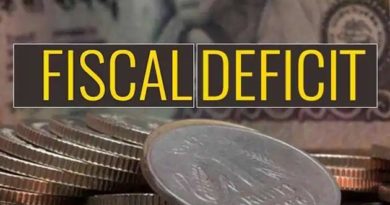Economic Survey 2023: Indian economy to grow 6-6.8 per cent next fiscal year
Economic Survey 2023: Indian economy to grow 6-6.8 per cent next fiscal year
India’s economy is projected to slow to 6-6.8 per cent in the fiscal year starting April – still remaining the fastest growing major economy in the world – as extraordinary challenges facing the globe will likely hurt exports, the Economic Survey said.
The projection of India’s gross domestic product (GDP) growth is higher than the 6.1 per cent estimate of the International Monetary Fund (IMF) and compares with the survey’s estimated 7 per cent expansion in the current fiscal year (April 2022 to March 2023) and 8.7 per cent in the previous year. The survey that details the state of the economy was tabled in Parliament by Finance Minister Nirmala Sitharaman a day before she presents Union Budget 2023-24.
“At least three shocks have hit the global economy since 2020,” the report, prepared by Chief Economic Adviser V Anantha Nageswaran, said.
Starting with the pandemic-induced contraction of the global output, the Russian-Ukraine conflict last year led to a worldwide surge in inflation. And then, central banks across economies led by the US Federal Reserve responded with synchronised policy rate hikes to curb inflation.
The rate hike by the US Fed drove capital into the US markets causing the US dollar to appreciate against most currencies. This led to the widening of the Current Account Deficits (CAD) and increased inflationary pressures in net importing economies like India.
“The Indian economy, however, appears to have moved on after its encounter with the pandemic, staging a full recovery in FY22 (April 2021 to March 2022) ahead of many nations and positioning itself to ascend to the pre-pandemic growth path in FY23.
“Yet in the current year, India has also faced the challenge of reining in inflation that the European strife accentuated,” the survey said.
However, the challenge of the depreciating rupee, although better performing than most other currencies, persists with the likelihood of further increases in policy rates by the US Fed. The widening of the CAD may also continue as global commodity prices remain elevated and the growth momentum of the Indian economy remains strong, it said.
The survey stated that the inflation projection by RBI at 6.8 per cent for current fiscal (FY23) is above the central bank’s tolerance limit but the pace of price increase is not high enough to deter private consumption or low enough to weaken investment.
According to the survey, the pressure on the Indian rupee could continue due to the tightening of monetary policy. CAD may also remain elevated as imports could remain high due to a strong local economy while exports ease due to weakness in the global economy.
India’s CAD was 4.4 per cent of GDP in July-September period, higher than 2.2 per cent a quarter ago and 1.3 per cent a year ago, as rising commodity prices and a weak rupee increased the trade gap.
The survey said there has been an improvement in employment conditions in India due to stronger consumption but a pick-up in private investment is essential to creating more jobs.
“The loss of export stimulus is further possible as the slowing world growth and trade shrinks the global market size in the second half of the current year.” It indicated that while inflation may not be too worrisome, borrowing costs are likely to remain ‘higher for longer’ as an entrenched inflation may prolong the tightening cycle. (10.03.23)
India’s recovery from the pandemic was relatively quick, growth will be supported by solid domestic demand, pick-up in capital investment, the survey said but highlighted the challenge to the rupee with the likelihood of further interest rate hikes by the US Fed.
“The survey projects a baseline GDP growth of 6.5 per cent in real terms in FY24,” the report said. “The actual outcome for real GDP growth will probably lie in the range of 6 per cent to 6.8 per cent, depending on the trajectory of economic and political developments globally.” CAD may continue to widen as global commodity prices remain elevated and because of strong economic growth momentum. If CAD widens further, the rupee may come under depreciation pressure, it said, adding the overall external situation will remain manageable.
On exports, it said the growth moderated in the second half of current fiscal year. Slowing world growth, shrinking global trade led to loss of export stimulus in the second half of the current year.
India’s economic growth in FY23 has been principally led by private consumption and capital formation. It has helped generate employment as seen in the declining urban unemployment rate and in the faster net registration in the Employee Provident Fund.
“Still, private capex soon needs to take up the leadership role to put job creation on a fast track,” the survey said.
A slowdown in global growth will likely push down global commodity prices and improve India’s CAD in FY24. “However, a downside risk to the Current Account Balance stems from a swift recovery driven mainly by domestic demand and, to a lesser extent, by exports,” it said. “The CAD needs to be closely monitored as the growth momentum of the current year spills over into the next.” Growth is expected to be brisk in FY24 as a vigorous credit disbursal and capital investment cycle are expected to unfold in India with the strengthening of the balance sheets of the corporate and banking sectors.
Further support to economic growth will come from the expansion of public digital platforms and path-breaking measures such as PM GatiShakti, the National Logistics Policy, and the Production-Linked Incentive schemes to boost manufacturing output.
“Economy has nearly recouped what was lost, renewed what had paused, and re-energised what had slowed during the pandemic and since the conflict in Europe,” it said.
Pegging nominal growth at 11 per cent for 2023-24, the survey said the growth in the financial year beginning April 1 will remain strong relative to most global economies, led by sustained private consumption, a pick-up in lending by banks and improved capital spending by corporations.
The optimistic growth forecasts stem from a number of positives like the rebound of private consumption giving a boost to production activity, higher capital expenditure, and near universal vaccination coverage enabling people to spend on contact-based services such as restaurants, hotels, shopping malls and cinemas.
The return of migrant workers to cities to work on construction sites leading to a significant decline in housing market inventory is also a factor for the optimistic growth projection, it said.
The strengthening of the balance sheets of corporates, well-capitalised public sector banks ready to increase the credit supply and the credit growth to micro, small and medium enterprises (MSME) sector have also helped.
Startup funding surges beyond hubs
The year 2022 was when the startup world’s shine began to wear off as macroeconomic factors slowed consumer spending. It was also when some new contender cities made their way onto the startup hub charts, and these are expected to grow their share in coming years.
While in terms of absolute values, the usual suspects — Bangalore, Delhi and Mumbai —continued to top the table in 2022, these cities recorded a decline in total investment raised by startups on a year-on-year basis. Chennai, Hyderabad and Pune emerged as top gainers in terms of deal value.
Data sourced from research firm Venture Intelligence showed that Chennai and Hyderabad were the big-gest gainers (see graphic). Experts told TOI this is likely due to B2B and enterprise tech emerging as top picks in a difficult funding environment, and investors getting selective with deploying dry powder to more economically solid companies. Investors noted that their portfolio today is more diverse with successful bets made on founders from Jaipur, Surat, Coimbatore and other non-metros. Investors said there is a drive among entrepreneurs from these cities, and the DNA of these founders is mostly about setting up an efficient, profitable business and they are, by nature, frugal.
VC firm Inflection Point Ventures (IPV), which clocked the largest number of early-stage deals in 2022, said that technology simplified access to entrepreneurs and ideas across the country. “2022 showed that, as investors, we need to get out of the FOMO mentality — ideas and fiscal discipline are more important than where founders come from,” IPV founder & CEO Vinay Bansal said.
Arali Ventures managing partner Arun Raghavan said that as the market matures, support ecosystems for startups take shape in places beyond the usual hubs. “The access to entry-level talent is also better and cheaper in smaller cities,” he added.
Research firm Tracxn’s data also showed that Pune, Chennai and Hyderabad have grown their share of funding and saw hectic unicorn activity in 2022. Three startups turned unicorns this year from Pune, two from Chennai, and one from Hyderabad, Tracxn co-founder Neha Singh said.
Ideaspring Capital managing partner Naganand Doraswamy said that 2021 was perhaps an anomaly and a “year of irrational exuberance”, thus making 2022 a funding winter in comparison. “But learnings like ensuring profitability, being frugal and achieving unit economics are key lessons from 2022, and will be taken forward for 2-3 years,” he said.




